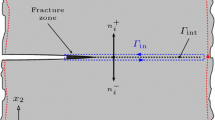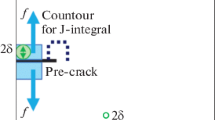Abstract
A numerical procedure for estimating the critical dynamic energy release rate (\(G_{IDc}\)), based on experimental data is proposed. A generation phase simulation is conducted where fracture parameters can be determined using an experimentally measured crack propagation history (position of the crack tip as a function of time). The discrete element method is used to simulate the dynamic fracture by implementing a node release technique at the crack tip. The results are compared with analytical data on the dynamic propagation of a crack in a semi infinite plate. It reveals that the node release technique causes dynamic instabilities that can only be corrected by adding numerical damping on the edges of the crack or in the entire sample. On the other hand, the progressive node release technique, based on an elasto-damage zone model does not generate dynamic instabilities. It is shown that for a linear relaxation scheme and a damage zone length equal to the mean radius of the discrete elements, results comparable to finite element or analytical methods are obtained in plate structure. The present model offers an alternative to the finite element method to simulate self-similar or more complex crack growth. It also gives a first proper analysis of the evaluation of the critical dynamic energy release rate in a lattice-discrete model.















Similar content being viewed by others
References
Andre D, Charles J-L, Iordanoff I, Néauport J (2014) The granoo workbench, a new tool for developing discrete element simulations, and its application to tribological problems. Adv Eng Softw 74:40–48
André D, Iordanoff I, Charles J-L, Néauport J (2012) Discrete element method to simulate continuous material by using the cohesive beam model. Comput Methods Appl Mech Eng 213:113–125
André D, Jebahi M, Iordanoff I, Charles J-L, Néauport J (2013) Using the discrete element method to simulate brittle fracture in the indentation of a silica glass with a blunt indenter. Comput Methods Appl Mech Eng 265:136–147
Aoki S, Kishimoto K, Sakata M (1987) Finite element computation of dynamic stress intensity factor for a rapidly propagating crack using ĵ-integral. Comput Mech 2(1):54–62
Brabel B (2007) Modélisation avec la méthode X-FEM de la propagation dynamique et de l’arret de fissure de clivage dans un acier de cuve REP. Thèse, Institut National des Sciences Appliquées de Lyon
Broberg KB (1960) The propagation of a brittle crack. Arkiv Fysik 18(2):159–192
Cundall PA, Strack OD (1979) A discrete numerical model for granular assemblies. Geotechnique 29(1):47–65
Delaplace A, Desmorat R (2008) Discrete 3d model as complimentary numerical testing for anisotropic damage. Int J Fract 148(2):115
Delaplace A, Ibrahimbegovic A (2003) Discrete modeling of cracking of brittle materials in large relative motion and localization problem, pp 375–383. Springer, Netherlands
Egholm DL (2007) A new strategy for discrete element numerical models: 1. theory. J Geophys Res: Solid Earth 112(B5)
Fakhimi A, Villegas T (2007) Application of dimensional analysis in calibration of a discrete element model for rock deformation and fracture. Rock Mech Rock Eng 40(2):193–211
Fillot N, Iordanoff I, Berthier Y (2007) Modelling third body flows with a discrete element methoda tool for understanding wear with adhesive particles. Tribol Int 40(6):973–981
Granoo’s wiki. http://www.granoo.org
Grégoire D (2008) Initiation, propagation, arrêt et redémarrage de fissures sous impact. Thèse, Institut National des Sciences Appliquées de Lyon
Guessasma M, Fortin, J (2011) Modélisation d’un milieu discret cohésif par l’approche dynamique des contacts: application à la rupture d’un matériau cimentaire. In 10e colloque national en calcul des structures, pages Clé–USB
Hedjazi L, Martin C, Guessasma S, Della Valle G, Dendievel R (2012) Application of the discrete element method to crack propagation and crack branching in a vitreous dense biopolymer material. Int J Solids Struct 49(13):1893–1899
Hsu T, Zhai Z (1984) A finite element algorithm for creep crack growth. Eng Fract Mech 20(3):521–533
Jalali P, Hyppänen T (2015) Momentum transport between two granular phases of spherical particles with large size ratio: two-fluid model versus discrete element method. Powder Technol 273:13–18
Kannan K, Kumar RK, Prabhakar O (1993) Finite element crack growth algorithm for dynamic fracture. Comput Mech 12(6):349–359
Kawabata T, Nakanishi D, Namegawa T, Aihara S (2018) Dissipation energy during brittle crack propagation in a single crystal of 3% si-fe alloy. Mater Phys Mech 36(1):18–38
Keegstra P, Head J, Turner C (1978) Numerical methods in fracture mechanics. University College, Swansea, pp 634–647
Kobayashi A, Emery AF, Mall S (1976) Dynamic-finite-element and dynamic-photoelastic analyses of two fracturing homalite-100 plates. Exp Mech 16(9):321–328
Kobayashi A, Mall S, Urabe Y, Emery A (1977) A numerical dynamic fracture analyses of three wedge-loaded dcb specimens. Technical report, DTIC Document
Kopp J-B, Fond C, Hochstetter G (2018) Rapid crack propagation in pa11: an application to pipe structure. Eng Fract Mech
Kopp J-B, Lin J, Schmittbuhl J, Fond C (2014a) Longitudinal dynamic fracture of polymer pipes. Eur J Environ Civ Eng 18(10):1097–1105
Kopp J-B, Schmittbuhl J, Noel O, Lin J, Fond C (2014b) Fluctuations of the dynamic fracture energy values related to the amount of created fracture surface. Eng Fract Mech 126:178–189
Kostylev V, Margolin V (1990) Fem solution of a dynamic elastoplastic problem of fracture mechanics. 2. Supercritical crack propagation. Strength Mater 22(7):943–953
Malluck J, King W (1980) Fast fracture simulated by conventional finite elements: a comparison of two energy-release algorithms. In: Crack arrest methodology and applications. ASTM International
Masurel A (2015) Modélisation mixte éléments discrets/éléments finis de la dégradation de structures en béton armé sous impact sévère. PhD thesis, Université Grenoble Alpes
Menouillard T (2007) Dynamique explicite pour la simulation numérique de propagation de fissure par a méthode des éléments finis étendus. Thèse, Institut National des Sciences Appliquées de Lyon
Nishioka T (1995) Recent developments in computational dynamic fracture mechanics. Dynamic fracture mechanics(A 96–14151 02–39). Southampton, United Kingdom and Billerica, MA, Computational Mechanics Publications 1995:1–60
Nishioka T (1997) Computational dynamic fracture mechanics. Int J Fract 86(1–2):127–159
Nishioka T, Atluri S (1982) Numerical analysis of dynamic crack propagation: generation and prediction studies. Eng Fract Mech 16(3):303–332
Nishioka T, Atluri S (1984) Path-independent integral and moving isoparametric elements for dynamic crack propagation. AIAA J 22(3):409–414
Nishioka T, Atluri SN (1980) Numerical modeling of dynamic crack propagation in finite bodies, by moving singular elementspart 1: formulation. J Appl Mech 47(3):570–576
Nistor I (2005) Identification expérimentale et simulation numérique de l’endommagement en dynamique rapide : application aux structures aéronautiques. Thèse, Institut National Polytechnique de Toulouse
Oliver-Leblond C, Delaplace A, Ragueneau F (2015) Modelling of three-dimensional crack patterns in deep reinforced concrete structures. Eng Struct 83:176–186
Réthoré J (2005) Méthode éléments finis étendus en espace et en temps : Application a la propagation dynamique des fissures. Thèse, Institut National des Sciences Appliquées de Lyon
Rougier E, Munjiza A, John N (2004) Numerical comparison of some explicit time integration schemes used in dem, fem/dem and molecular dynamics. Int J Numer Methods Eng 61(6):856–879
Rydholm G, Fredriksson B, Nilsson F (1978) Numerical methods in fracture mechanics. In: Luxmoore AR, Owen DRJ (eds) University College, Swansea, pp 660–672
Song J-H, Wang H, Belytschko T (2008) A comparative study on finite element methods for dynamic fracture. Comput Mech 42(2):239–250
Swenson D, Ingraffea A (1988) Modeling mixed-mode dynamic crack propagation nsing finite elements: theory and applications. Comput Mech 3(6):381–397
Vassaux M, Oliver-Leblond C, Richard B, Ragueneau F (2016) Beam-particle approach to model cracking and energy dissipation in concrete: Identification strategy and validation. Cem Concr Compos 70:1–14
Yagawa G, Sakai Y, Ando Y (1977) Analysis of a rapidly propagating crack using finite elements. In: Fast fracture and crack arrest. ASTM International
Yanagimoto F, Shibanuma K, Nishioka Y, Shirai Y, Suzuki K, Matsumoto T (2018) Local stress evaluation of rapid crack propagation in finite element analyses. Int J Solids Struct
Zhou F, Molinari J-F, Shioya T (2005) A rate-dependent cohesive model for simulating dynamic crack propagation in brittle materials. Eng Fract Mech 72(9):1383–1410
Acknowledgements
This work was carried out in the frame of the FUI project SAMBA funded by BPI, région Midi-Pyrénées, région Aquitaine and approved by the Aerospace Valley. The SAMBA project, (for Shock Absorber Material for Birdshield Application), backed by STELIA Design and Research Division, concerns the development of new generation bird impact shields for commercial and business aircraft. The authors gratefully acknowledge the members of the project: STELIA (AirbusGroup), CEDREM, ESTEVE, NIMITECH, HUTCHINSON, Institut Clément Ader and ATECA SAS. The authors would also like to show their gratitude to Christophe Fond, Professor at the University of Strasbourg for sharing his expertise on dynamic fracture.
Author information
Authors and Affiliations
Corresponding author
Ethics declarations
Conflict of interest
The authors declare that there are no conflicts of interest regarding the publication of this paper.
Disclosure
Part of this work was presented at the Fifth International Conference on Computational Modeling of Fracture and Failure of Materials and Structures (2017) in Nantes, France.
Additional information
Publisher's Note
Springer Nature remains neutral with regard to jurisdictional claims in published maps and institutional affiliations.
Appendix: Elastic calibration
Appendix: Elastic calibration
The first step in the elastic calibration is to ensure that the discrete meshing is fine enough to retrieve the macroscopic elastic properties obtained experimentally. The numerical convergence is assumed when the macroscopic parameters such as Young’s modulus and the Poisson ratio converge to one value, Fig. 17. To achieve this convergence, several discrete cylindrical domains from 500 to 35,000 elements were created, see in Fig. 16. Each of them was generated five times in order to use the average for each discrete domain refinement and to quantify the dispersion.
A numerical compressive test on each specimen is then performed. A load force is imposed on each side of the cylinder (on each center of elements belonging respectively to the top and bottom set of the cylinder), progressively applied and stabilized. Only elastic properties of the model are investigated so plates are not simulated and friction between the plates and the cylinder is not considered. The rate of loading forces is chosen to ensure a quasi-static solicitation and therefore to have a negligible kinetic energy compared to the total energy. Young’s macroscopic modulus and the Poisson ratio are estimated knowing the force applied at the top and bottom and the change in length and radius of the cylinder. According to the two top charts in Fig. 17, a discrete element number greater than 15,000 is found to converge: Young’s modulus and Poisson ratio values are within ±2.5 %. Microscopic parameters are scanned, interpolated and finally selected, see the two bottom charts in Fig. 17 and Table 2.
Rights and permissions
About this article
Cite this article
Coré, A., Kopp, JB., Girardot, J. et al. Dynamic energy release rate evaluation of rapid crack propagation in discrete element analysis. Int J Fract 214, 17–28 (2018). https://doi.org/10.1007/s10704-018-0314-7
Received:
Accepted:
Published:
Issue Date:
DOI: https://doi.org/10.1007/s10704-018-0314-7






